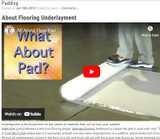Padding

About Flooring Underlayment
Underlayment is the broad term for the variety of materials that roll out
onto your subfloor
subfloor, going between it and your flooring proper,
laminate flooring, hardwood or carpet. No pad is used with vinyl. The main purposes served
are to block moisture, absorb sound from a
floating floor
(where pad is a necessity), smooth out very minor imperfections in a
subfloor, and provide a bit of insulation for the room.
Almost all underlayment comes in the form of a roll, and most roll out with the proper side facing up. Some laminate products come with pad attached to the back of them. Here are the basics on the various types and their uses. Carpet Pad is the only kind of pad carpet uses. The others are all for laminate or hardwood flooring.
Moisture Barriers
Your moisture barrier, or vapor barrier, will be a roll of thin, polyethylene plastic sheeting. It’s usually 6 mil thick (“6 mil”? That means 6 micrometers, or 6 tenths of a millimeter). Its job is in its name, to protect everything above it from moisture rising up through a floor.
It is an absolute must over concrete, because a concrete floor sits right on the ground, so it’s subject to environmental changes. You will also want it to go over any floor that is directly above an unfinished basement or crawlspace. If not over one of these, moisture barriers are generally not needed, and sometimes not even recommended, over a wood subfloor.
It will be the bottom layer of any complement of padding, and is usually recommended to go up the walls a few inches as you install it. Once the floor is in place, you can remove the excess with an exacto knife.
A moisture barrier is never part of the attached pad on a laminate product. You see, when you roll it out, you have this nice, thick section of plastic. You will overlap the next section and tape the two sections together to make a good seal. Now you really want as few seams as possible, and if there was moisture barrier on each plank of a laminate product, there would be as many seams as there are planks – times four, for each side of the plank. And that much tape. It just wouldn’t work.
On the other hand, moisture barrier almost always is included with rolls of padding you buy separately.
Basic Foam Pad
Most underlayment is made from a synthetic, polyethylene foam, and is typically 2mm to 4mm (1/16″ to 1/8″) thick. Often this padding comes with a moisture barrier attached, as well as a taping system. Such padding will usually meet the minimum requirements for installation of a floating floor, and can be used both at and below ground level.
While these combination pads are very convenient, they usually only meet the bare minimum for what can be done with padding. One thing they will not do very much of is sound absorption. Upgrades to thicker, high density underlayments, made of closed cell materials or felt, can be well worth it for the sound killing features they provide for both the room of, and below, the installation. They can also provide a little bit better insulation, and more smoothing of very minor subfloor imperfections.
Rubber Underlayment
It’s usually made of recycled rubber. It usually comes in the same thicknesses as foam, but it has a higher density than the basic foam pads, which means improved sound absorption and moisture resistance. Rubber pad can come in rolls, and is becoming the more frequent style of attached pad.
Vinyl
Vinyl flooring, over which one can often install a new floating floor, is an excellent
moisture barrier. You would not need an additional moisture barrier if you
were installing under these circumstances. You would still need a regular
pad, foam, felt or rubber, between the vinyl and the new floor, but your
moisture issues would be taken care of.
Cork Underlayment
Cork underlayment is considered by some to be the best available. It is exceptionally dense and stable, so your floor is not just cushioned, but supported. Your laminate flooring will feel – not uncomfortably solid, but sturdier, and much quieter than a floor with just foam underneath. It is available in both rolls and sheets, and a range of thicknesses. Unlike the padding, cork can be used with non-floating floors as well as floating floors. In those cases it must be glued down first (gluing it down is an option with any floor). Since cork is so replenishable, it’s another good flooring option for the environmentally conscious.
Carpet Padding
This is much softer than padding for other types of flooring. While
carpet
is already a soft flooring, the proper padding makes it feel that much
softer, sound that much quieter and insulate that much better. It tends to
be made of felt, rubber, jute*, urethane or synthetic fibers. Carpet padding
is never suitable for laying underneath wood or laminate or flooring.
Now many websites will refer to an ability of an underlayment to compensate
for subfloor imperfections. You should consider this with caution. At best,
a difference of a couple of millimeters of dip or rise over a 10 foot
stretch might be handled, but underlayment is not going to even out a
subfloor. There are proper methods to take care of larger than minor issues,
and we recommend that you consider those, rather than the claims of an
underlayment manufacturer or seller.
Related blog post: Do I Need This? on Accessories & Trims
* “Jute?” Jute is a vegetable fiber, like cotton. It’s used in making rope, sacks, carpets, area rugs curtains and other common things.
– – – –
David has written and made videos about flooring products and installation since 2011 at Floors To Your Home (.com), where he is also the PPC Manager, a Researcher, a Website & Marketing Strategy Team member, Videographer, Social Strategist, Photographer and all around Resource Jito. In my spare time I shoot and edit video, put together a podcast, explore film history, and mix music (as in ‘play with Beatles multi-tracks’). Connect with
W. David Lichty
Follow Team Floors To Your Home on Facebook

 Brown Tone
Brown Tone
 Red Tone
Red Tone
 Golden Tone
Golden Tone
 Gray Tone
Gray Tone
 Light Tone
Light Tone
 Medium Tone
Medium Tone
 Dark Tone
Dark Tone
 Brown Tone
Brown Tone
 Red Tone
Red Tone
 Golden Tone
Golden Tone
 Gray Tone
Gray Tone
 Light Tone
Light Tone
 Medium Tone
Medium Tone
 Dark Tone
Dark Tone
 Multi Color
Multi Color
